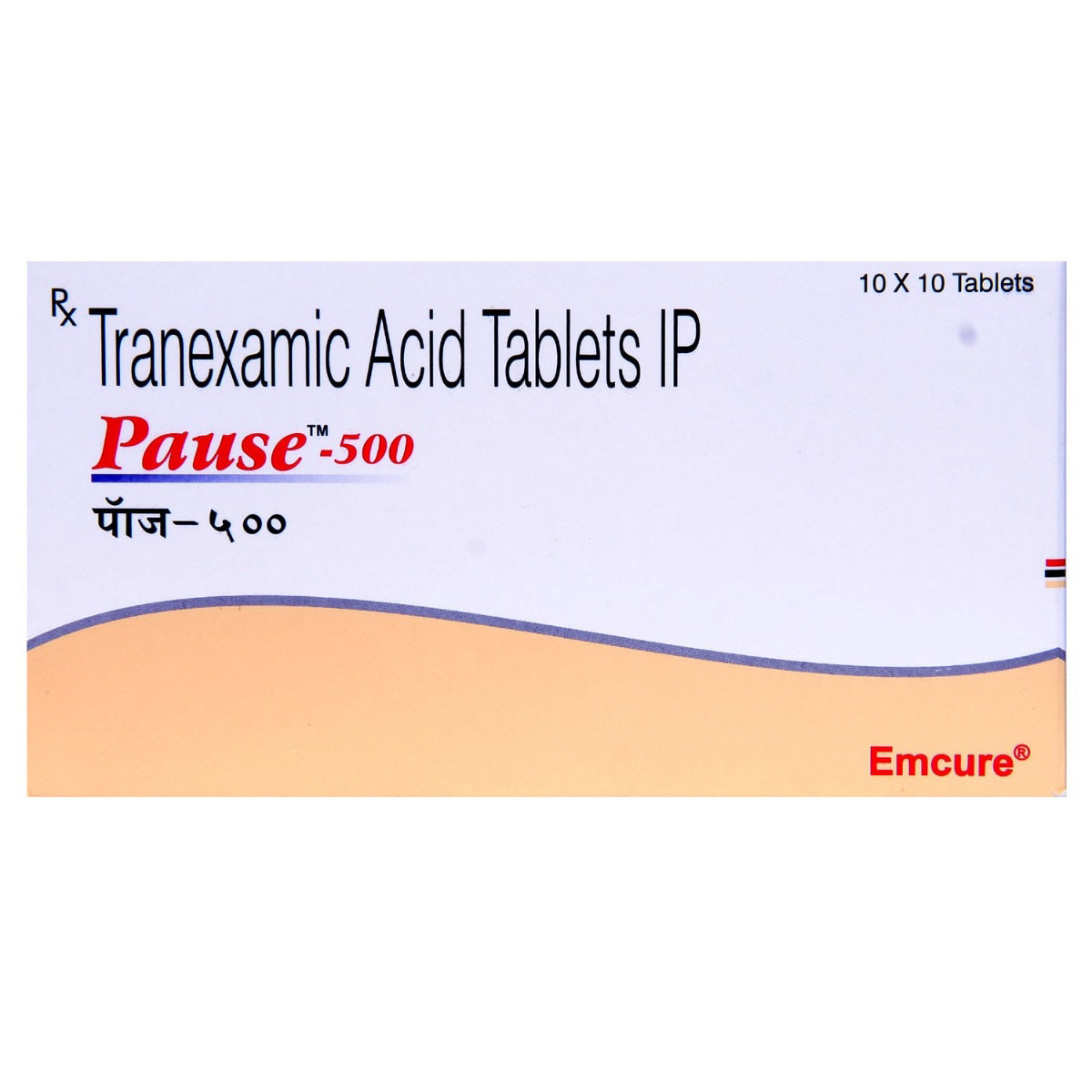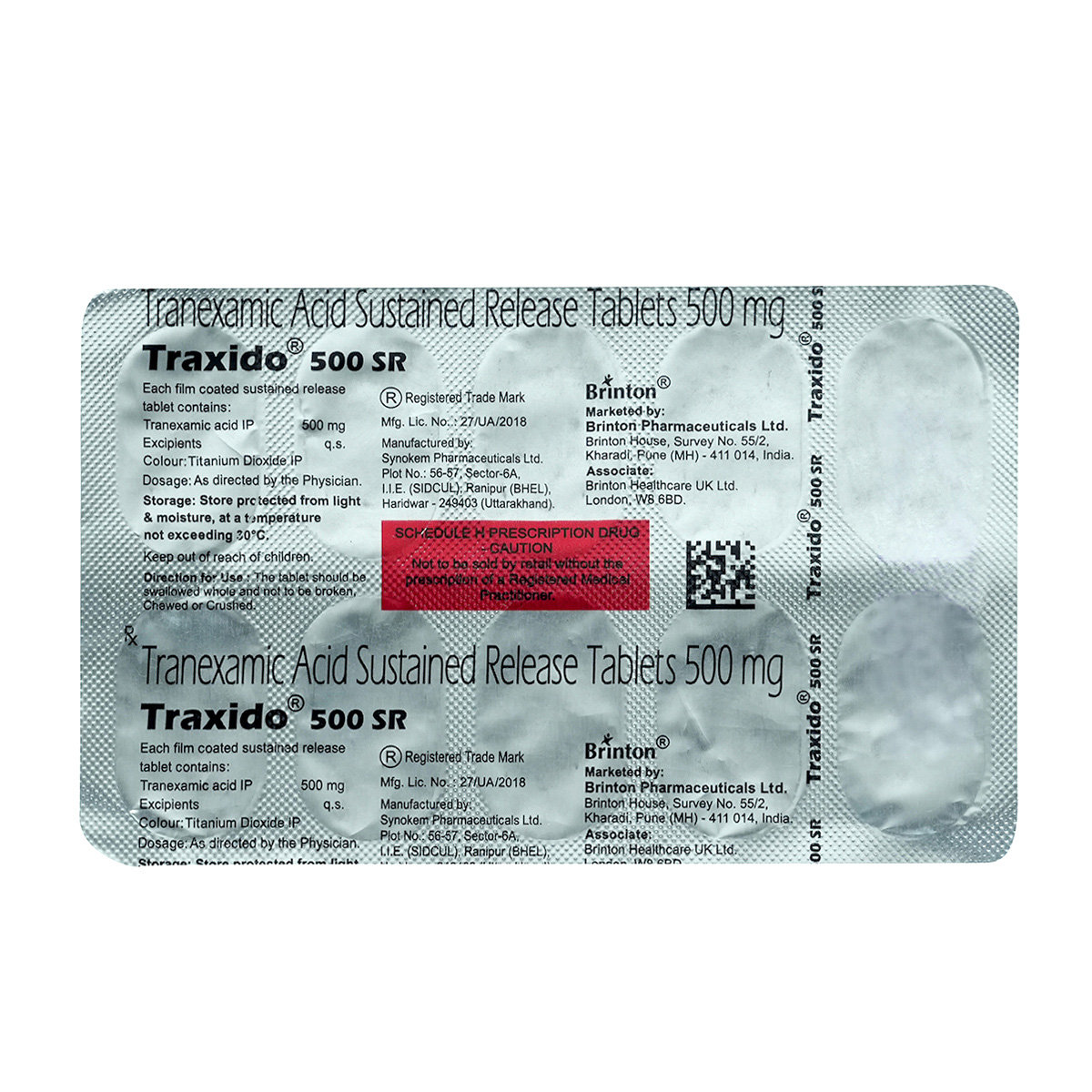Tranesma SR 500 Tablet 10's


MRP ₹181.5
(Inclusive of all Taxes)
₹27.2 Cashback (15%)
Provide Delivery Location
Online payment accepted
 Prescription drug
Prescription drugWhats That
Composition :
Manufacturer/Marketer :
Consume Type :
Expires on or after :
Return Policy :
About Tranesma SR 500 Tablet
Tranesma SR 500 Tablet belongs to the class of medications called ‘anti-fibrinolytic drugs’ used to treat abnormal or unwanted bleeding. It is used to control bleeding in conditions such as heavy periods (menorrhagia), nose bleeds (epistaxis), cervical surgery (conization of the cervix), prostate surgery (post-prostatectomy), bladder surgery (post-cystectomy), bleeding inside the eye (traumatic hyphaema) and a hereditary disease called angioneurotic edema (HANO). The solution form of this medicine is used before tooth removal (dental extraction) in hemophiliacs (people who bleed more easily than normal).
Tranesma SR 500 Tablet contains ‘tranexamic acid’, which belongs to the class of ‘anti-fibrinolytic agents’. It is generally used for short-term treatment of bleeding. It acts by regulating the breakdown of blood clots. It blocks the release and action of plasmin which is an enzyme essential for the breakdown of clots present in the blood. This effect helps to slow down the bleeding.
Tranesma SR 500 Tablet should be taken as advised by your physician. The dose and duration of the medicine will be decided by your doctor based on your health condition. Tranesma SR 500 Tablet may not cause any side effects when used orally. However, some patients may experience certain side effects, such as feeling sick (nausea), diarrhea, and itchy skin. These side effects usually go away on their own. If you develop any other serious side effects, such as vision problems while using Tranesma SR 500 Tablet , consult your doctor immediately.
Tranesma SR 500 Tablet should be avoided if you are allergic to it or any other ingredients present in it. Do not take this medicine if you have a history of kidney disease, thrombosis (formation of blood clots in the blood vessels), disseminated intravascular coagulation (a disease where blood clots form throughout your body) , and seizures (fits). Inform your doctor if you are taking birth control pills or fibrinolytic agents (medicines that dissolve blood clots). Also, inform your doctor if you are pregnant, planning to become pregnant or breastfeeding.
Uses of Tranesma SR 500 Tablet
Directions for Use
Key Benefits
Tranesma SR 500 Tablet contains ‘tranexamic acid’, which belongs to the class of ‘anti-fibrinolytic agents’. It acts by regulating the breakdown of blood clots in the body. It blocks the release and action of plasmin, an enzyme essential for the breakdown of clots in the blood. This effect helps to slow down abnormal bleeding.
Storage
Drug Warnings
Before taking Tranesma SR 500 Tablet , inform your doctor if you notice blood in your urine (except during periods), or have a history of uncontrollable bleeding, disseminated intravascular coagulation (DIC) (a disease where blood clots form throughout your body), irregular periods, and kidney disease. Also, inform your doctor if you or your family has a history of thrombosis (formation of blood clots in the blood vessels). Let your doctor know if you are taking medicine to treat a hereditary disease called angioneurotic edema (HANO) every day for a long time. Your doctor may advise regular eye tests and blood tests to check your vision problems and also liver/kidney functioning. Inform your doctor if you are using birth control pills, including the patch, vaginal ring, and an intrauterine device (IUD), as there is a risk of deep vein thrombosis (a condition in which a blood clot is formed in the deeper vein, mostly the legs). Inform your doctor if you are using fibrinolytic agents (drugs that break blood clots) such as streptokinase, as they may stop the effect of Tranesma SR 500 Tablet . Inform your doctor if you are pregnant, planning to become pregnant or breastfeeding.
Diet & Lifestyle Advise
- Ask your doctor about the preferred exercises to do based on your health condition.
- Stay hydrated and consume plenty of fluids. Fluids are necessary to maintain blood flow in your body.
- Consume fresh fruits and vegetables. Consult a dietitian and prepare a diet plan. Eating healthy can help you to recover faster.
Side Effects of Tranesma SR 500 Tablet
- Nausea
- Diarrhea
- Itchy skin
- Pain at the injection site
- Vision problems
- Vomiting
Habit Forming
Therapeutic Class
All Substitutes & Brand Comparisons
RX
Texakind Tablet 10's
Mankind Pharma Pvt Ltd
₹156
(₹14.04 per unit)
14% CHEAPERRX
Tyrodin-FSR Tablet 10's
Canixa Life Sciences Pvt Ltd
₹176
(₹15.84 per unit)
3% CHEAPERRX
Texid Tablet 10's
Rapross Pharmaceuticals Pvt Ltd
₹180
(₹16.2 per unit)
Product Substitutes
FAQs
Drug-Drug Interactions Checker List
- CHLORPROMAZINE
- TRETINOIN
- STREPTOKINASE
- UROKINASE
- ALTEPLASE
- RETEPLASE
- LEVONORGESTREL
Special Advise
- Your doctor may suggest regular eye check-ups while taking Tranesma SR 500 Tablet .
- Increased risk of blood clot formation when co-administered with a combination oral contraceptive. Consult your doctor before taking any medication.
Disease/Condition Glossary
Menorrhagia: It is a condition characterized by heavy or prolonged bleeding during menstrual periods which last for more than seven days
Epistaxis: Bleeding from the nose when the blood vessels of the nose lining burst. This can occur due to dryness or nose injury.
Post-operative bleeding: It is bleeding after surgery due to the blood vessel rupture. Some people may experience mild to severe bleeding due to cuts made during surgery.
Traumatic hyphema: It is a condition characterized by the presence of blood in the anterior chamber of the eye due to a blunt injury. This condition may also result in vision loss.
Hereditary angioneurotic edema (HANO): It is a hereditary disease that causes recurrent painless swelling under the skin.
Dental Procedures: It is a procedure involving dental issues during which bleeding occurs.

Have a query?
Alcohol
Safe if prescribed
Tranesma SR 500 Tablet may not interact with alcohol. However, avoid the consumption of alcohol as it may worsen your health condition.
Pregnancy
Consult your doctor
Tranesma SR 500 Tablet is a category B medicine and may not cause toxic effects to the fetus. However, it should be used in pregnant women only when prescribed by a doctor. Your doctor will administer it only if the benefits overweigh the risk.
Breast Feeding
Consult your doctor
Tranesma SR 500 Tablet should be used in breastfeeding mothers only if prescribed by a doctor. Your doctor will administer it only if the benefits overweigh the risk.
Driving
Safe if prescribed
The oral for of tranexamic acid may cause dizziness. Hence it is advised to avoid driving or operating machines for some period after receiving Tranesma SR 500 Tablet .
Liver
Consult your doctor
Tranesma SR 500 Tablet should be used with caution in patients with liver diseases. Your doctor may suggest for a dose adjustment if needed based on your health condition.
Kidney
Consult your doctor
Tranesma SR 500 Tablet should be used with caution in patients with kidney diseases. Your doctor may suggest for a dose adjustment if needed based on your health condition.
Children
Safe if prescribed
Tranesma SR 500 Tablet should be used in children below 12 years of age only if clinically needed. Dose adjustments are done by the child specialist.
















